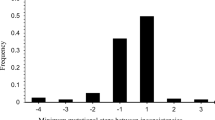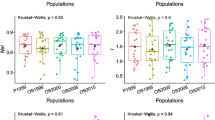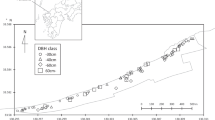Abstract
Three stands ofPicea abies [L.] Karst. with different density in the Harz Mountains (Lower Saxony, Germany) were characterized at 4 microsatellite loci. An excess of homozygotes was observed in all 3 stands at 1 simple sequence repeat (SSR) locus, suggesting the presence of null alleles. To test for the segregation of a null allele, 24 openpollinated seeds (haploid megagametophytes and embryos) from apparently homozygous mother trees were analyzed. For 1 of 3 trees that could be identified as heterozygous for a null allele, no significant deviation from the expected 1∶1 segregation into marker absence (null allele) and marker presence of the second maternal allele could be observed in the haploid megagametophyte. Concordantly, the numbers of embryos heterozygous for the null allele and for the other maternal allele were not significantly different from each other. Inheritance analyses in seedlings and corresponding megagametophytes of gymnosperms were used as a direct experimental verification of microsatellite null alleles in single-tree progeny. Microsatellites with an abundance of null alleles should be discarded from further analysis because inclusion of these loci results in incorrect estimation of allele frequencies.
Similar content being viewed by others
Abbreviations
- HWE:
-
Hardy-Weinberg equilibrium
- SSR:
-
simple sequence repeat
References
Berg EE and Hamrick JL (1997) Quantification of genetic diversity at allozyme loci. Can J Forest Res 27: 415–424.
Callen DF, Thompson AD, and Shen Y (1993) Incidence and origin of “null” alleles in the (AC)n microsatellite markers. Am J Hum Genet 52: 922–927.
Devey ME, Bell JC, Uren TL, and Moran GF (2002) A set of microsatellite markers for fingerprinting and breeding applications inPinus radiata. Genome 45: 984–989.
Fisher PJ, Richardson TE, and Gardner RC (1998) Characteristics of single- and multi-copy microsatellites fromPinus radiata. Theor Appl Genet 96: 969–979.
Gillet E and Hattemer HH (1989) Genetic analysis of isoenzyme phenotypes using single tree progenies. Heredity 63: 135–141.
Hodgetts RB, Aleksiuk MA, Brown A, Clarke C, Macdonald E, Nadeen S, and Khasa D (2001) Development of microsatellite markers for white spruce (Picea glauca) and related species. Theor Appl Genet 102: 1252–1258.
Ishibashi Y, Saitoh T, Abe S, and Yoshida C (1996) Null microsatellite alleles due to nucleotide sequence variation in the grey-sided voleClethrionomys rufocanus. Mol Ecol 5: 589–590.
Jones AG and Ardren WR (2003) Methods of parentage analysis in natural populations. Mol Ecol 12: 2511–2523.
Jones AG, Stockwell CA, Walker D, and Avise JC (1998) The molecular basis of a microsatellite null allele from the White Sands pupfish. J Hered 89: 339–342.
Khasa PD, Newton CH, Rahman MH, Jaquish B, and Dancik BP (2000) Isolation, characterization, and inheritance of microsatellite loci in alpine larch and western larch. Genome 43: 439–448.
Müller G (1976) A simple method of estimating rates of self-fertilization by analysing isozymes in tree seeds. Silvae Genet 25: 15–17.
Pastorelli R, Smulders MIM, Westende Van't WPC, Vosman B, Giannini R, Vetori C and Vendramin GG (2003) Characterization of microsatellite markers inFagus sylvatica L. andFagus orientalis Lipsky. Mol Ecol 3: 76–78.
Peakall R and Smouse PE (2001) GenAlEx V5: Genetic analysis in excel. Population genetic software for teaching and research. Australian National University, Canberra, Australia. Accessed 18 May 2005. <http://www.anu.edu.au/BoZo/GenAlEx/>.
Pemberton JM, Slate J, Bancroft DR, and Barret JA (1995) Nonamplifying alleles at microsatellite loci: a caution for parentage and population studies. Mol Ecol 4: 249–252.
Pfeiffer A, Olivieri AM, and Morgante M (1997) Identification and characterization of microsatellites in Norway spruce (Picea abies K.). Genome 40: 411–419.
Schneider S, Roessli D, and Excoffier L (2000) ARLEQUIN, version 2.000. A Software for Population Genetics Data Analysis. Genetics and Biometry Laboratory, Department of Anthropology and Ecology, University of Geneva, Switzerland. Accessed 18 May 2005. <http://anthro.unige.ch/arlequin>.
Scotti I, Paglia GP, Magni F, and Morgante M (2002) Efficient development of dinucleotide microsatellite markers in Norway spruce (Picea abies Karst.) through dot-blot selection. Theor Appl Genet 104: 1035–1041.
Sefc KM, Regner F, Turetschek E, Glossl J, and Steinkellner H (1999) Identification of microsatellite sequences inVitis riparia and their applicability for genotyping of differentVitis species. Genome 42: 367–373.
Sokal RR and Rohlf FJ (1998) Biometry, 3rd ed, W. H. Freeman and Company, New York.
Stachel M, Leley T, Grausgruber H, and Vollmann J (2000) Application of microsatellites in wheat (Triticum aestivum L.) for studying genetic differentiation caused by selection for adaptation and use. Theor Appl Genet 100: 242–248.
Streiff R, Ducousso A, Lexer C, Steinkellner H, Gloessl J, and Kremer A (1999) Pollen dispersal inferred from paternity analysis in a mixed oak stand ofQuercus robur L. andQuercus petraea (Matt.) Liebl. Mol Ecol 8: 831–842.
Vornam B, Decarli N, and Gailing O (2004) Spatial distribution of genetic variation in a natural beech stand (Fagus sylvatica L.) based on microsatellite markers. Conserv Genet 5: 561–570.
Author information
Authors and Affiliations
Corresponding author
Rights and permissions
About this article
Cite this article
Nascimento de Sousa, S., Finkeldey, R. & Gailing, O. Experimental verification of microsatellite null alleles in Norway spruce (Picea abies [L.] Karst.): Implications for population genetic studies. Plant Mol Biol Rep 23, 113–119 (2005). https://doi.org/10.1007/BF02772701
Issue Date:
DOI: https://doi.org/10.1007/BF02772701




